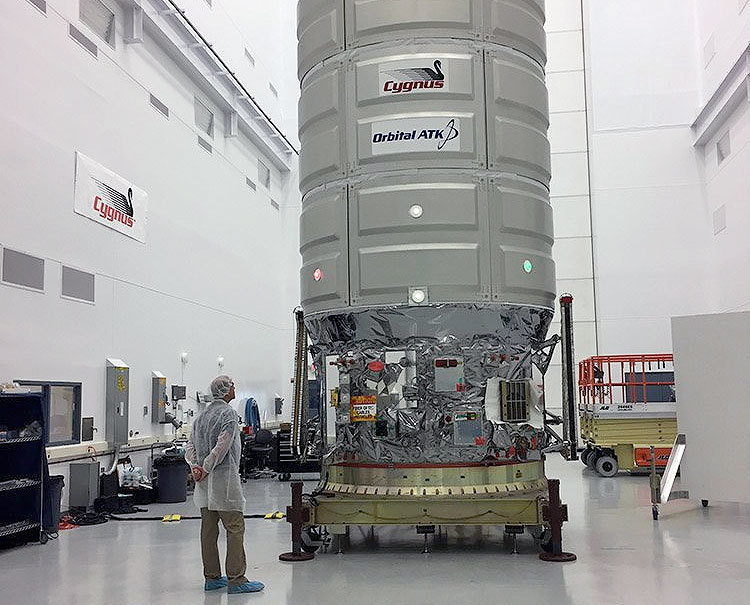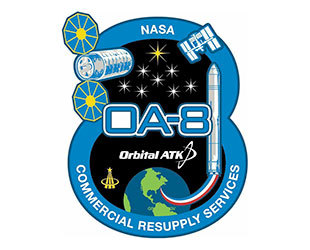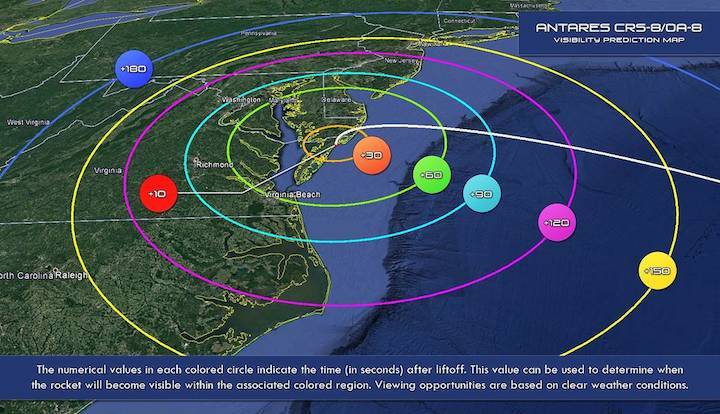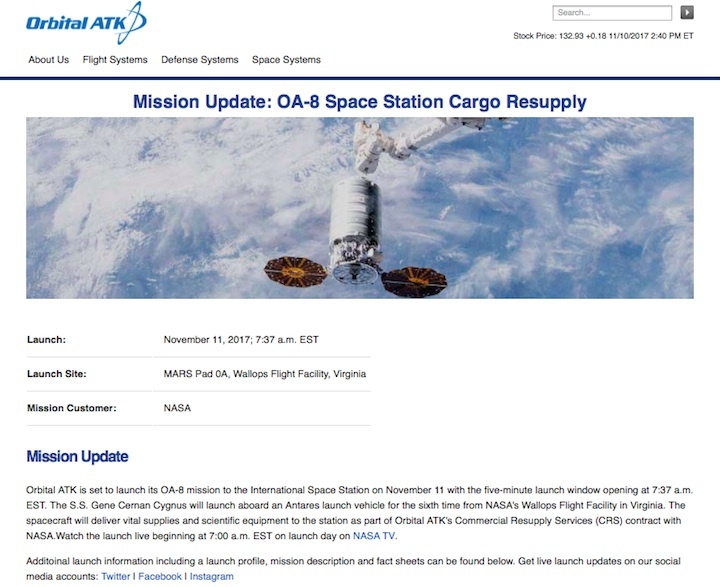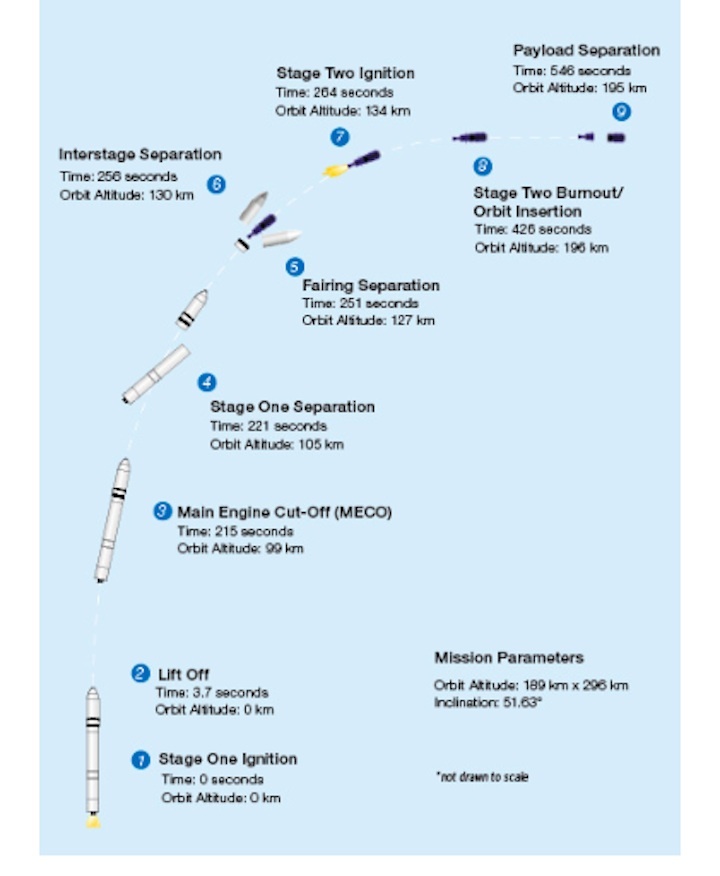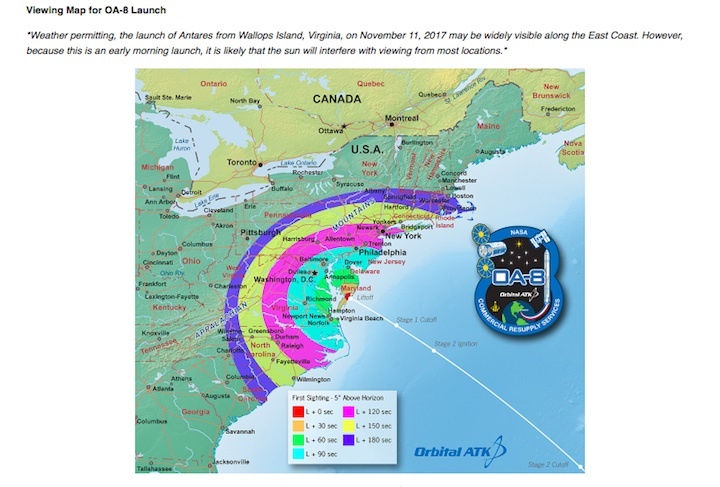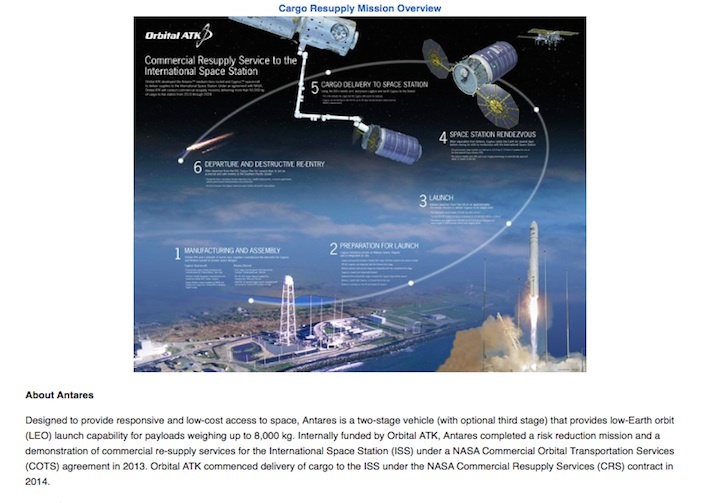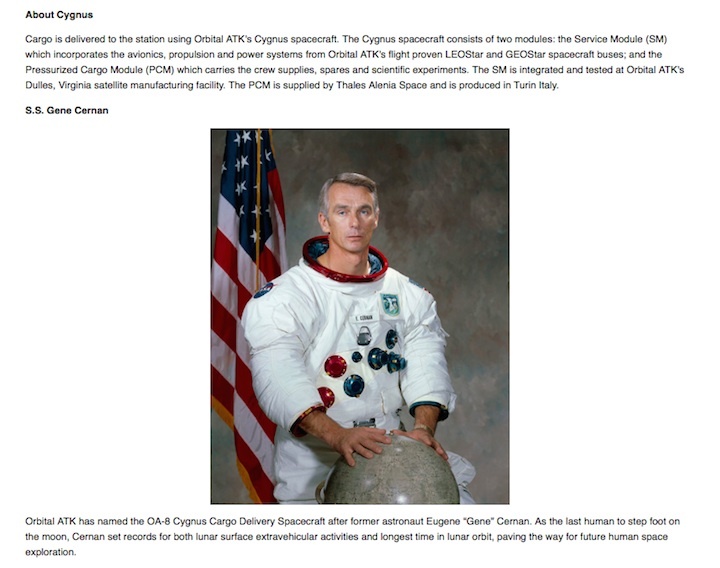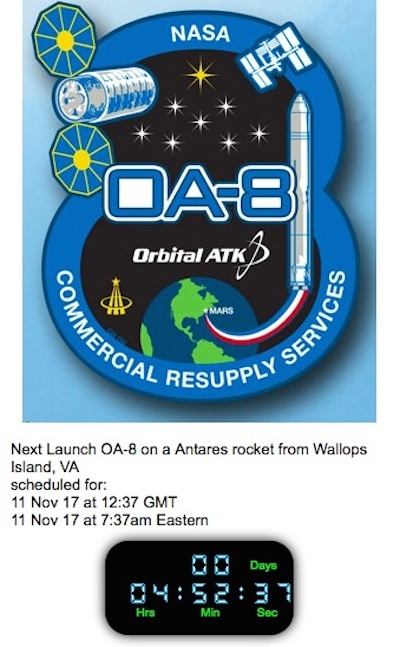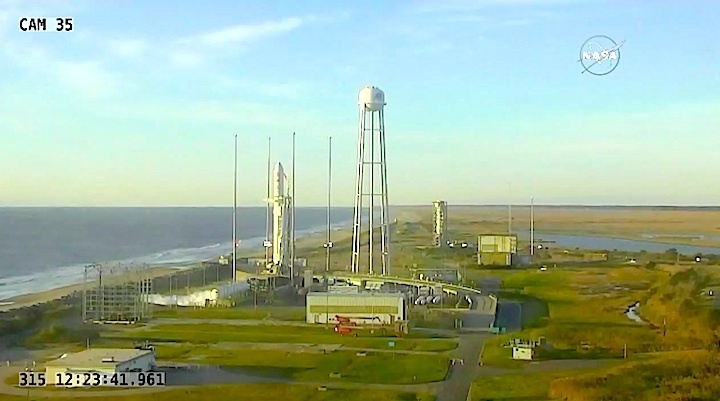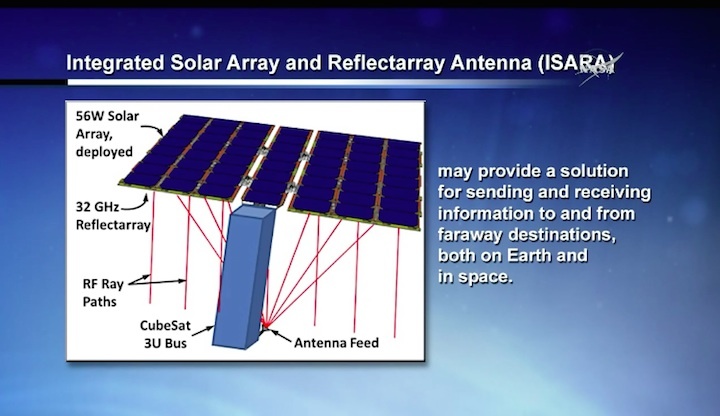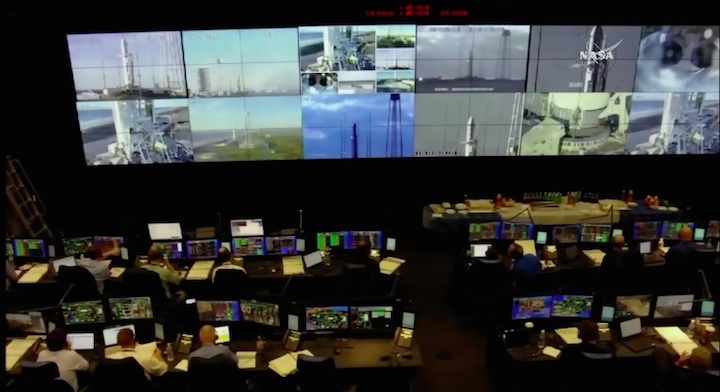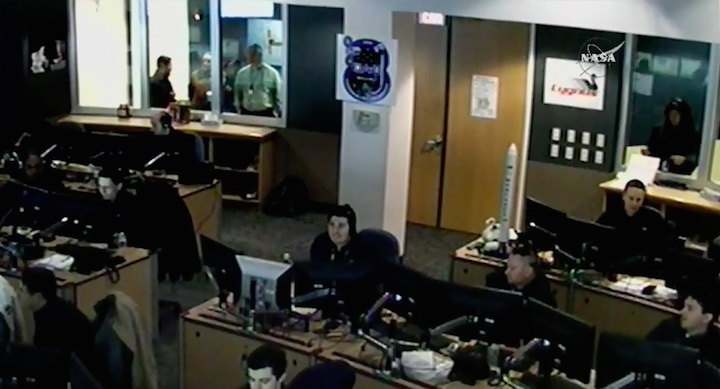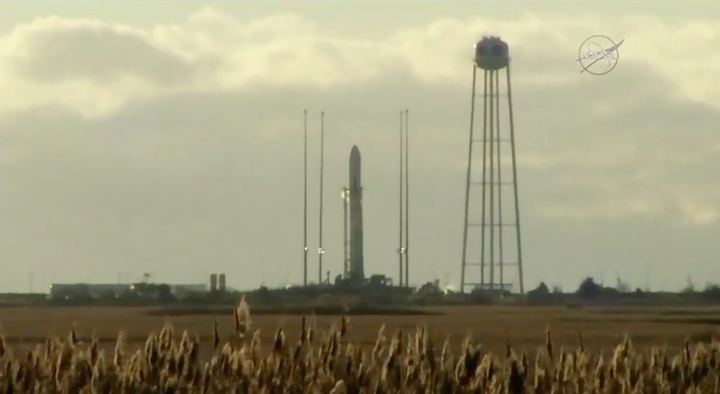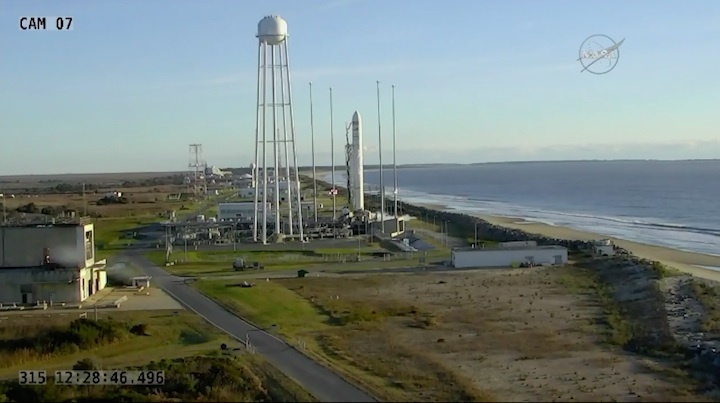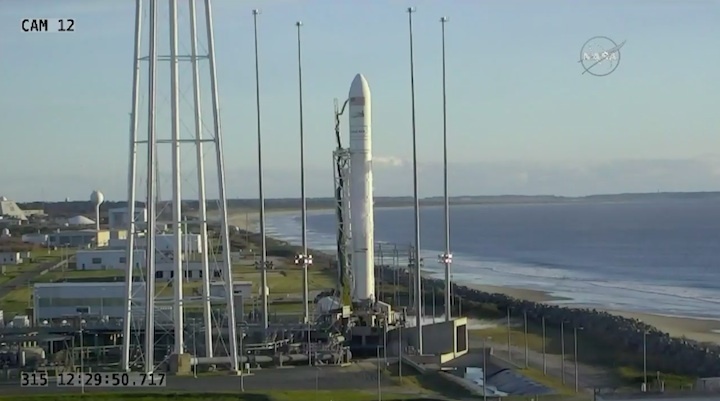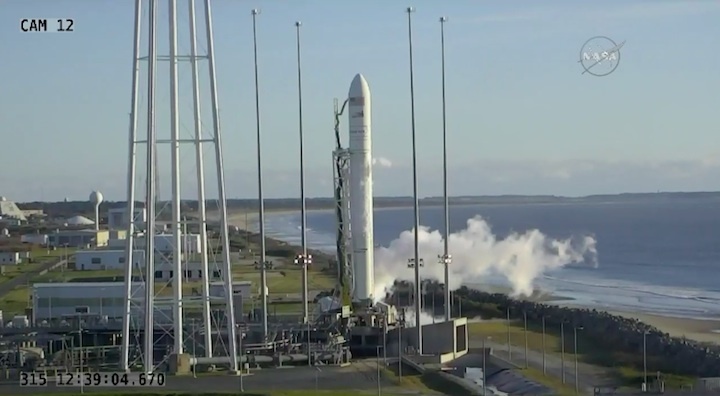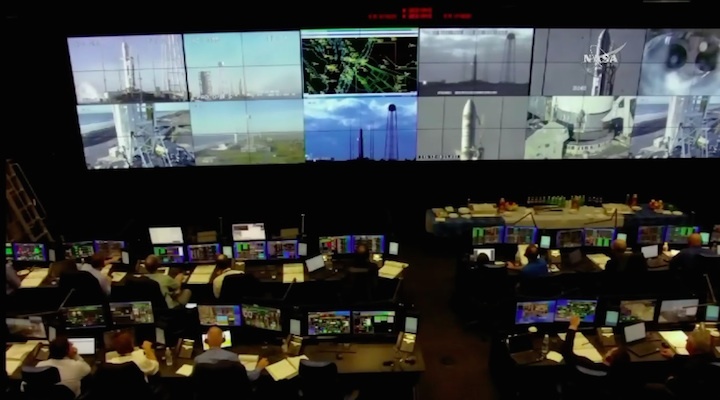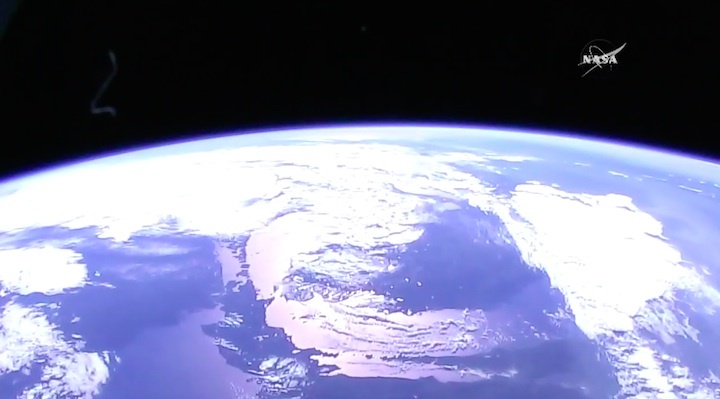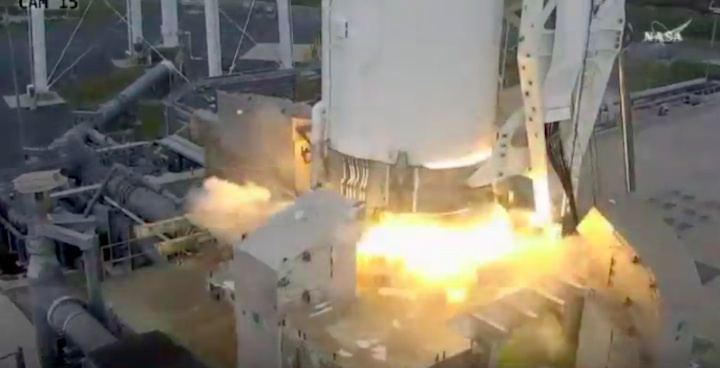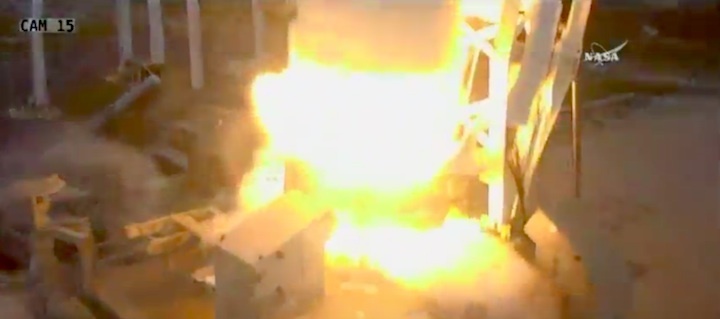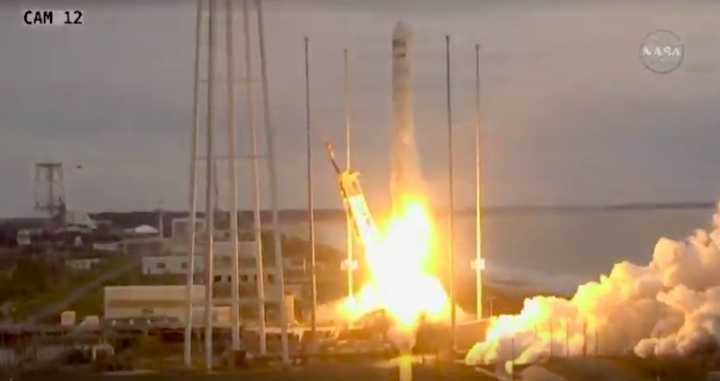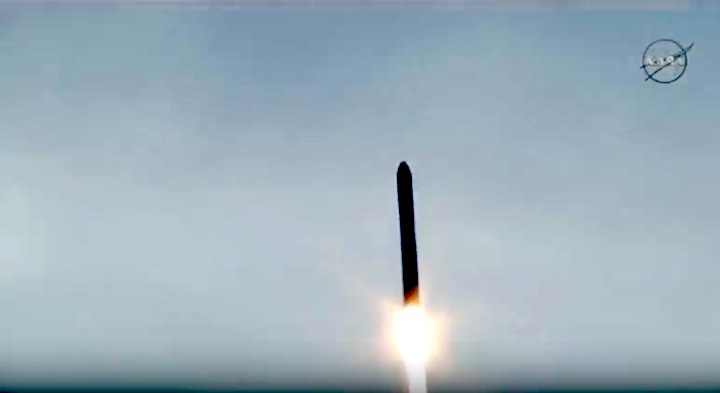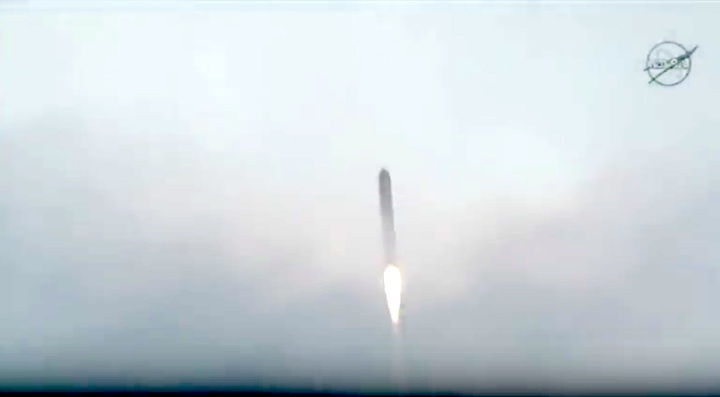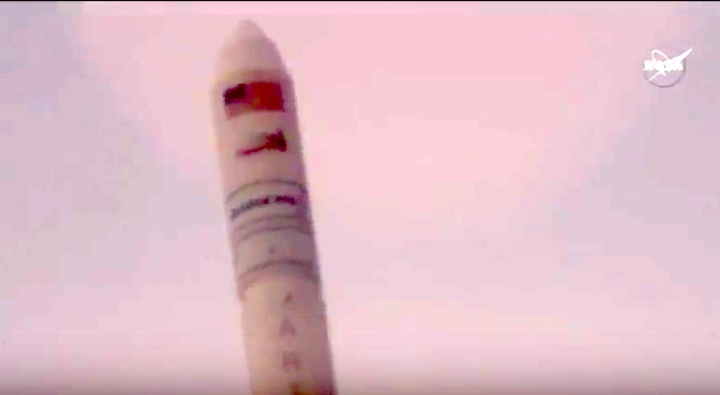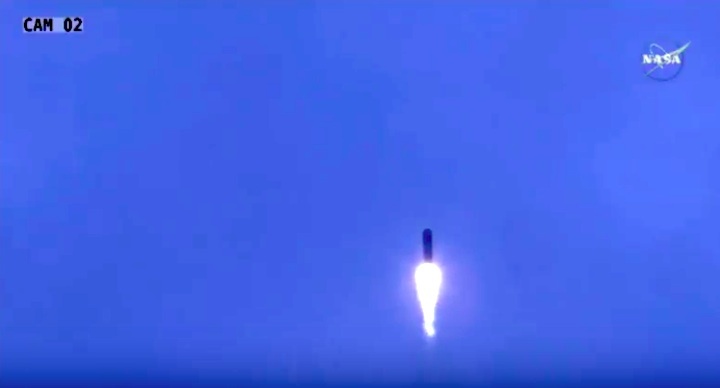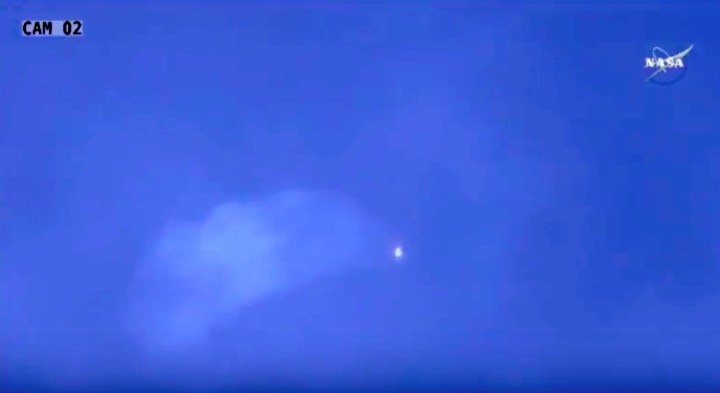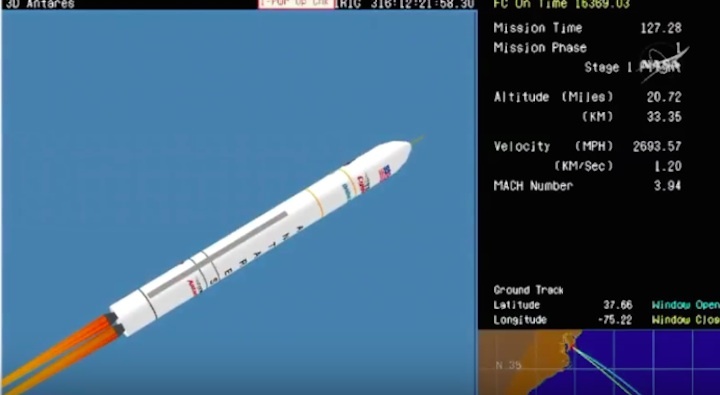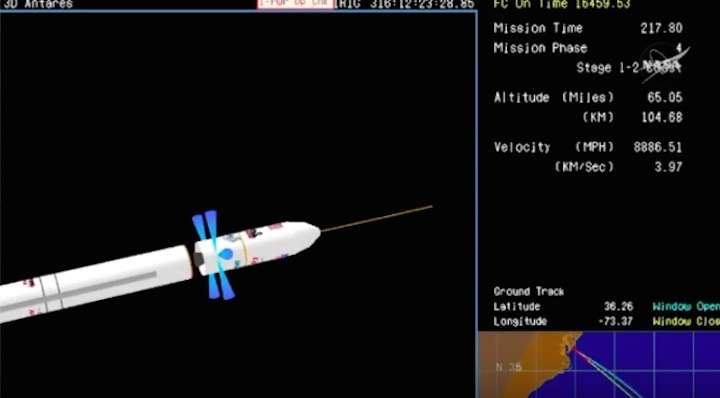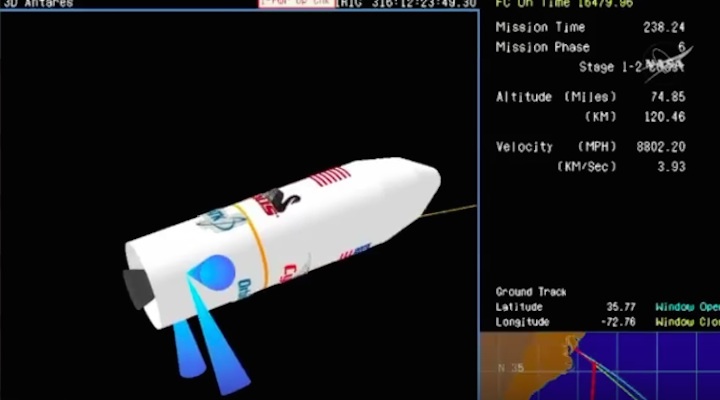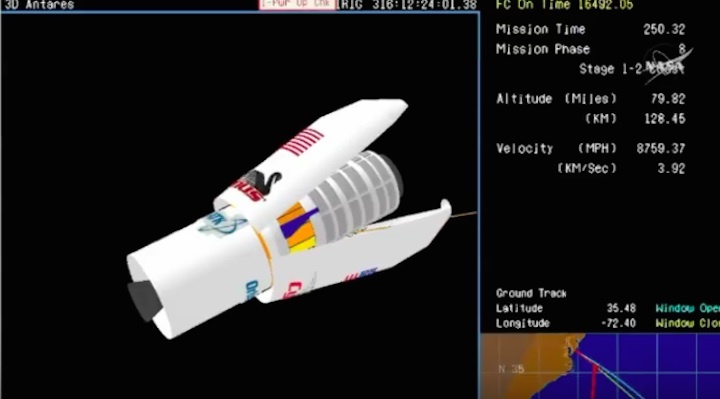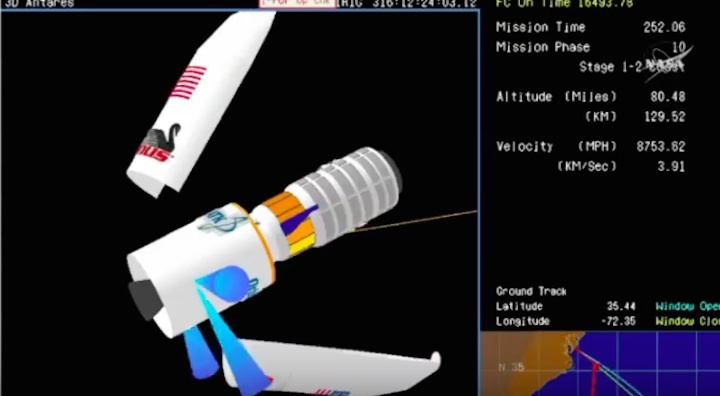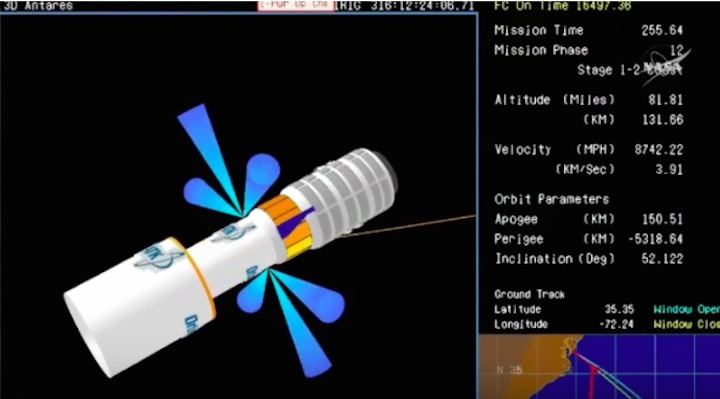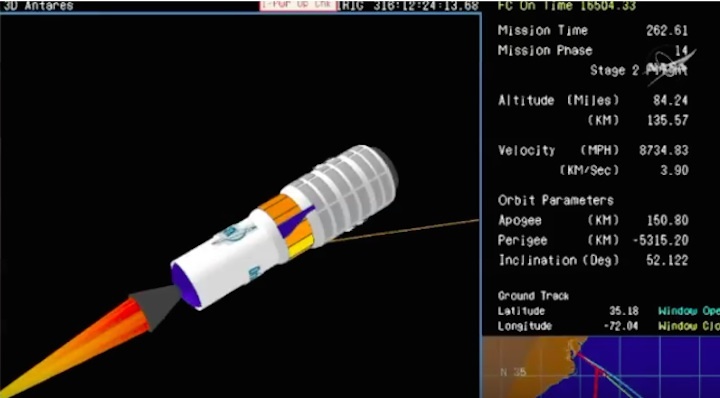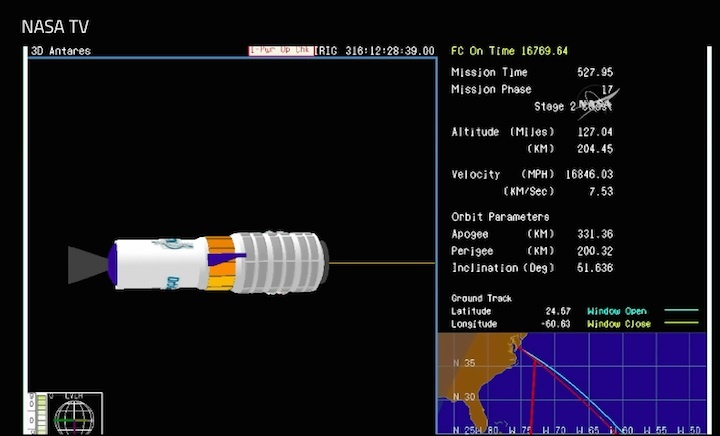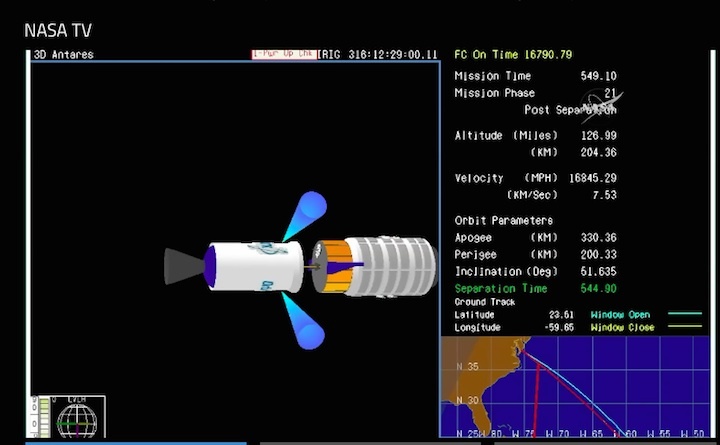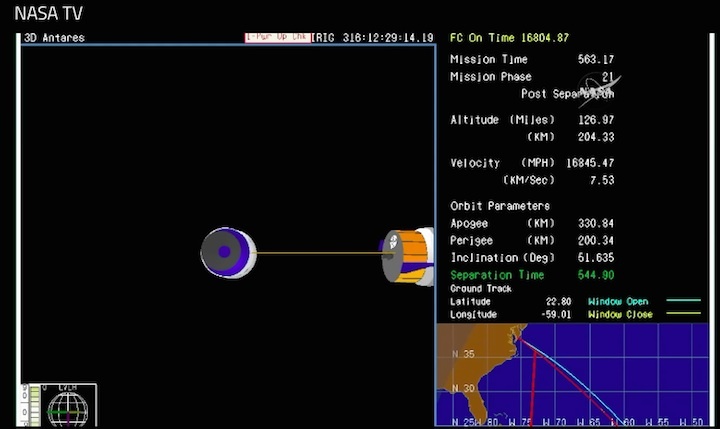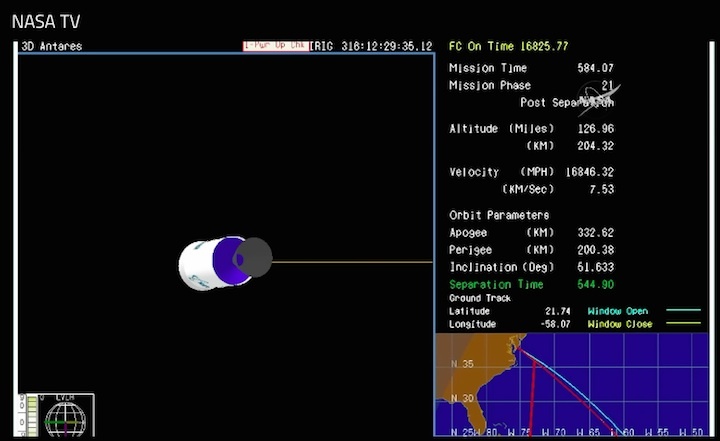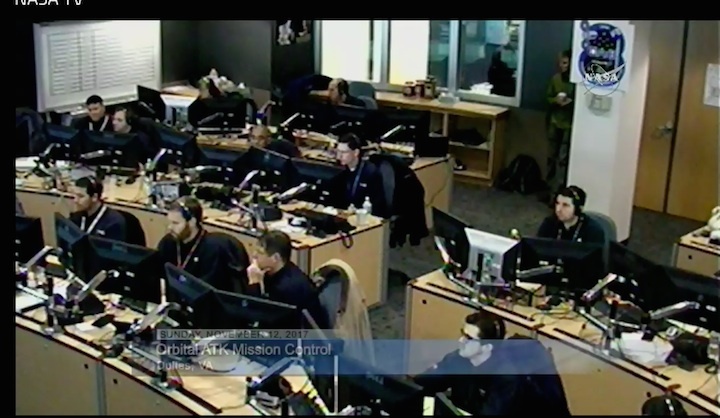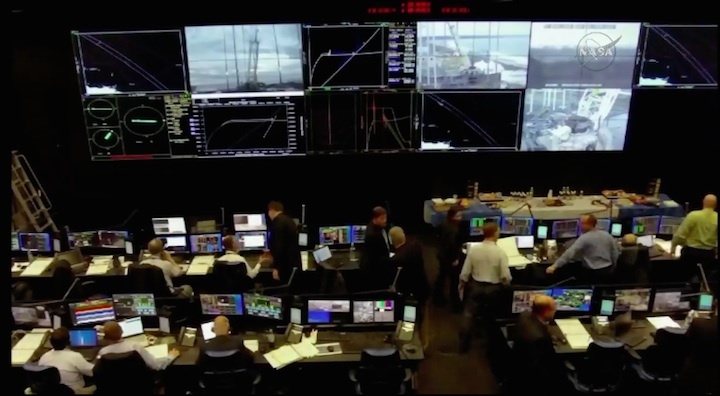16.06.2017
.
Orbital ATK OA-8E Cygnus cargo mission slated for late summer

Orbital ATK’s horizontal integration hangar at Wallops with multiple Antares rockets inside. Photo Credit: Patrick Black / NASA
On the heels of Orbital ATK’s successful OA-7 Cygnus cargo run, teams at Virginia’s Wallops Flight Facility are preparing for the OA-8E mission. The 139-foot (42.5-meter) tall Antares rocket is slated to take an enhanced Cygnus and several tons of science and cargo to the International Space Station on Sept. 12, 2017.
Kurt Eberly, the program manager for Antares, said that the company would have OA-8E ready to travel as early as late July and certainly in August if necessary. Regardless of when it does get off the ground, the mission will send 7,385 pounds (3,350 kilograms) of cargo packed inside an enhanced Cygnus spacecraft. Liftoff will take place from Pad 0A at Wallops Island, Virginia.
The OA-8E mission is part of the Commercial Resupply Services (CRS) 1 contract. The “E” signifies the CRS-1 contract extension, enabling NASA to cover space station resupply needs until the CRS-2 contract begins in 2019. Orbital ATK was awarded at least three additional Cygnus flights. SpaceX was also awarded additional flights.
image: http://www.spaceflightinsider.com/wp-content/uploads/2017/06/unnamed.jpg

MARS Pad 0A. Photo Credit: Patrick Black / NASA
After OA-8E will be OA-9E, which is currently scheduled to launch in March 2018 atop an Antares 230 rocket. The Antares rockets for both of these missions can be seen in the company’s horizontal integration facility.
The last Cygnus mission, OA-7, launched atop an Atlas V rocket from Cape Canaveral, Florida. While the spacecraft can be sent to space using either launch vehicle, there are currently no more plans for Orbital ATK to use the Atlas V.
Eberly said that by improving the performance of Antares, utilizing the pair of RD-181 engines, Orbital ATK is expected to achieve 13 percent higher thrust with 10 seconds of additional specific impulse (ISP). This should net 20–25 percent more mass to be delivered to orbit resulting in increased payload delivered to the ISS.
It is expected that, by OA-11E, Orbital ATK should be able to achieve its designed mass of 7,716 pounds (3,500 kilograms) of cargo and probably beyond in the CRS-2 missions.
For Antares’ second stage, there is a large Castor 30XL motor which is manufactured by the Propulsion Systems Division of Orbital ATK located in Utah.
Dale Nash, executive director at the Mid-Atlantic Regional Spaceport (MARS) on Wallops Island, indicated that Pad 0A should be ready for OA-8E by end of July.
Nash briefed the media that with the last Antares launch, in October 2016, the rocket lifted off quickly and, as a result, there was much less damage to the launch pad, thereby improving turnaround times between launches to about 30 days.
“Wallops has a fairly wide open azimuth between 38 to 60 degrees inclination which the ISS is right in the sweet spot for that,” Nash said, talking about the advantages of Wallops over Cape Canaveral. Additionally, he said that there are far fewer scheduling conflicts at the Wallops Flight Facility and less chance of getting bumped.
Moreover, improvements to the design of Cygnus itself, including strengthened internal infrastructure and an improved power supply, allows for better support of science payloads. Additionally, procedural protocols allowing for later cargo insertion into the Cygnus have proven to have significant advantages allowing for easier accommodation of NASA cargo requests.
Quelle: SpaceFlight Insider
---
Update: 7.10.2017
.
NASA Offers Access to Cygnus Spacecraft Ahead of Next Space Station Mission
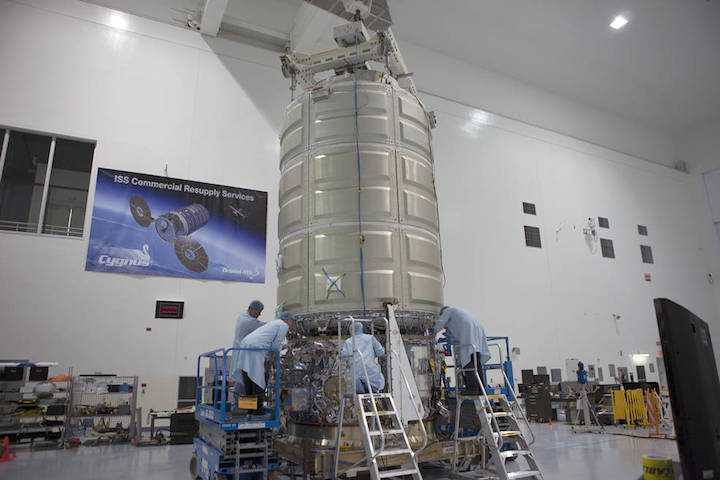
Media are invited to view and photograph Orbital ATK’s Cygnus spacecraft, packed with cargo and scientific experiments for its upcoming flight to the International Space Station, at 10:30 a.m. EDT Wednesday, Oct. 18, at NASA’s Wallops Flight Facility on Wallops Island, Virginia.
Media also will have an opportunity to speak with NASA and Orbital ATK officials about the targeted no earlier than Nov. 10 mission and the space agency’s effort to send supplies to the space station using commercial companies. The officials available at the event include:
- Sam Scimemi, director for the International Space Station, NASA Headquarters, Washington
- Rick Mastracchio, senior director of operations, commercial resupply services program, Orbital ATK, Dulles, Virginia
- Kurt Eberly, vice president, Antares, Orbital ATK
To attend this event, media must apply for accreditation by contacting Keith Koehler at keith.a.koehler@nasa.gov by noon, Tuesday, Oct. 17. Accreditation is open only to media who are U.S. citizens.
Orbital ATK will make its eighth Cygnus cargo delivery to the International Space Station under its commercial resupply services contract with NASA. The resupply mission will launch on the company’s Antares rocket from the Mid-Atlantic Regional Spaceport’s Pad 0A at Wallops.
Following the Cygnus viewing, media will have the opportunity to visit the upgraded Wallops Range Control Center.
Quelle: NASA
---
Update: 11.10.2017
.
Mission Update: OA-8 Space Station Cargo Resupply
Orbital ATK’s Cygnus spacecraft is scheduled to launch aboard an Antares launch vehicle for the sixth time from NASA’s Wallops Flight Facility in Virginia on November 10, 2017. Cygnus will deliver vital equipment, supplies and scientific equipment to the space station as part of Orbital ATK’s Commercial Resupply Services (CRS) contract with NASA.
About Antares
Designed to provide responsive and low-cost access to space, Antares is a two-stage vehicle (with optional third stage) that provides low-Earth orbit (LEO) launch capability for payloads weighing up to 8,000 kg. Internally funded by Orbital ATK, Antares completed a risk reduction mission and a demonstration of commercial re-supply services for the International Space Station (ISS) under a NASA Commercial Orbital Transportation Services (COTS) agreement in 2013. Orbital ATK commenced delivery of cargo to the ISS under the NASA Commercial Resupply Services (CRS) contract in 2014.
About Cygnus
Cargo is delivered to the station using Orbital ATK’s Cygnus spacecraft. The Cygnus spacecraft consists of two modules: the Service Module (SM) which incorporates the avionics, propulsion and power systems from Orbital ATK’s flight proven LEOStar and GEOStar spacecraft buses; and the Pressurized Cargo Module (PCM) which carries the crew supplies, spares and scientific experiments. The SM is integrated and tested at Orbital ATK’s Dulles, Virginia satellite manufacturing facility. The PCM is supplied by Thales Alenia Space and is produced in Turin Italy.
Quelle: Orbital ATK
---
Update: 21.10.2017
.
S.S. Gene Cernan: Space station resupply ship named for late moonwalker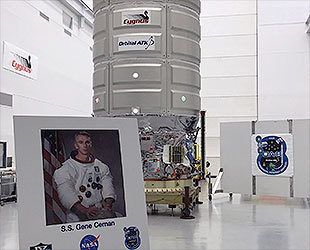
October 18, 2017
— The last human to step off the moon is the latest astronaut to be memorialized with the naming of a space station-bound cargo ship.
The Cygnus spacecraft will be outfitted with TangoLab, a reconfigurable general microgravity research facility. "This exercise will demonstrate the ability to expand the station's capabilities for hosting experiments," stated Orbital ATK.
In addition to being the last human to step off the moon's surface (to date), Cernan was the second U.S. astronaut to walk in space and one of only three people to fly to the moon twice. A veteran of three missions (Gemini 9, Apollo 10 and Apollo 17), Cernan logged more than 23 days in space, with more than 73 hours on the lunar surface. |
---
Update: 4.11.2017
-

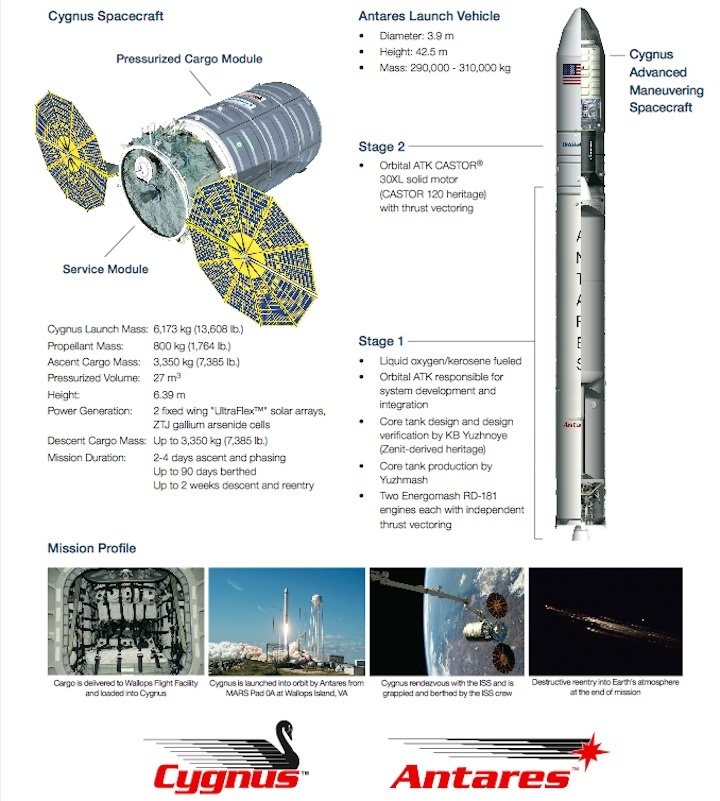

Quelle: Orbital ATK
---
Update: 5.11.2017
.
International Space Station U.S. National Lab Payloads Prepped for Orbital ATK CRS-8 Launch
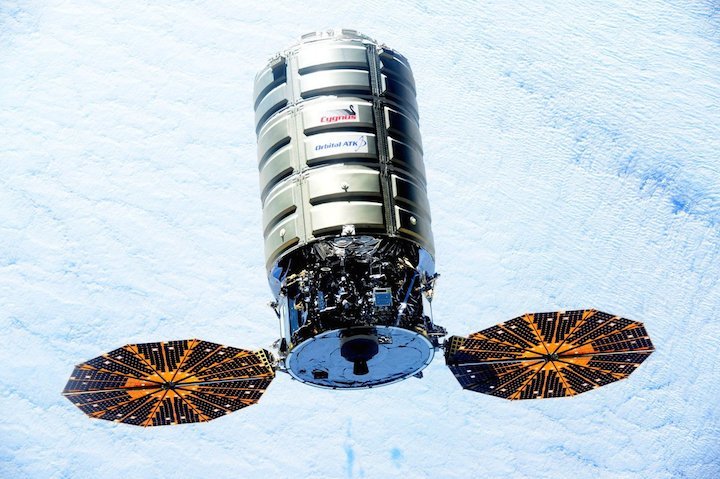
The Orbital ATK Cygnus vehicle is slated to launch to the International Space Station (ISS) no earlier than November 11, 2017 from Wallops Flight Facility. The Cygnus spacecraft will carry a dozen ISS National Laboratory payloads to conduct research across a variety of areas aimed at improving life on Earth. In addition to the diverse research launching to the ISS National Lab, multiple payloads focused on enabling future research missions will be part of the CRS-8 manifest. Thus far in 2017, the ISS National Lab has sponsored more than 100 separate experiments that have reached the station.
Below highlights ISS National Lab sponsored investigations as part of the Orbital ATK CRS-8 mission:
Biological Nitrogen Fixation via Rhizobium-Legume Symbiosis
Higher Orbits, Michelle Lucas
This project was developed by the Higher Orbits Go for Launch! student competition Orbital ATK Division winning team, the Saguaro Snakes (Gilbert, AZ). The project is focused on establishing a baseline for plant growth in extraterrestrial colonies. Microclover, a resilient and drought-tolerant legume will be grown in microgravity to determine the effect of the space environment on the nitrogen-fixation process and micro-green growth. Insight gained from this experiment could be useful in ongoing efforts to create a self-sufficient greenhouse in microgravity, which would necessitate a soil nitrogen source for exploratory purposes.
Hardware Partner: Space Tango
Cost-effective High E-Frequency Satellite (CHEFSat)
Naval Research Laboratory (Washington, DC)
The Cost-effective High E-Frequency Satellite (CHEFSat) tests and prepares consumer communications technology for use in space. The growing range of devices, components, and miniaturized technology available in the consumer market represents a boon for space exploration and cost management. CHEFSat seeks to validate a consumer-grade radio frequency device for wider space use by testing its safety and effectiveness in a working CubeSat deployed from the ISS.
Hardware Partner: NanoRacks
E. coli AntiMicrobial Satellite (EcAMSat)
Stanford University, A.C. Martin, Ph.D. (Stanford, CA)
The E. coli AntiMicrobial Satellite (EcAMSat) investigation seeks to determine the lowest dose of antibiotic needed to inhibit growth of Escherichia coli (E. coli), a bacterial pathogen that causes infections in humans and animals. The experiment will expose wild-type (naturally occurring in nature) and mutant strains of E. coli to three different antibiotic concentrations and then examine the viability of each group using a dye that reveals metabolic activity. As the first mission in the 6U satellite platform configuration, EcAMSat also serves to demonstrate the capabilities of this technology. EcAMSat is being developed through a partnership between NASA’s Ames Research Center with support from the NASA Space Life and Physical Sciences Research and Applications Program and the Stanford University School of Medicine.
Hardware Partner: NanoRacks
Effects of Microgravity on the Life Cycle of a Tenebrio molitor
Higher Orbits, Michelle Lucas
The Effects of Microgravity on the Life Cycle of Tenebrio Molitor (Tenebrio Molitor) experiment aboard the ISS investigates how the microgravity environment of space affects the mealworm life cycle. Mealworms represent good test subjects because they are well-studied organisms. An automated laboratory apparatus images mealworm growth from larval to adult life stages and then returns samples to Earth based labs for more detailed analysis. This project was conceived by the Higher Orbits AIAA Division winning team – Operation Galaxy X (Herndon, VA).
Hardware Partner: Space Tango
Integrated Solar Array and Reflectarray Antenna (ISARA)
Jet Propulsion Laboratory (Pasadena, CA) and Aerospace Corporation (El Segundo, CA)
The Integrated Solar Array and Reflectarray Antenna (ISARA) prepares a new hybrid antenna and power system for space applications by demonstrating its use in CubeSat-based environmental monitoring. Advances in material science and electrical engineering have made possible a flexible solar panel that can send and receive messages. ISARA tests the performance of these new solar antennas in collecting instrumental data aboard a CubeSat deployed from the ISS and monitored by ground-based engineering crews.
Hardware Partner: NanoRacks
Life Cycle of Arabidopsis Thaliana in Microgravity
Magnitude.IO, Ted Tagami (Berkeley, CA)
The Life Cycle of Arabidopsis thaliana in Microgravity (Arabidopsis thaliana) project studies the morphology and physiology of a common plant species using specialized modular growth chambers aboard the ISS. The plant under investigation grows from germinated seeds under automated light, temperature and nutrient conditions. Automated cameras image growth at every stage to determine both plant viability and the effectiveness of cultivation modules, which return to Earth for further post-mission analysis.
Hardware Partner: Space Tango
NanoRacks-LEMUR-2
Spire Global, Inc., Jenny Barna (San Francisco, SF)
About 90 percent of global trade is shipped by sea; however, tracking of oceangoing ships is inefficient and many ships are unmonitored as they transit the world’s oceans, far from land and out of range of ground-based beacons. The NanoRacks-LEMUR-2 satellites are part of a remote sensing satellite constellation that provides global ship tracking and weather monitoring. The satellites in this investigation are deployed from both the ISS and the visiting space vehicle, demonstrating the technology at a range of altitude bands.
Hardware Partner: NanoRacks
Optical Communication and Sensor Demonstration (OCSD)
Siegfried Janson, Ph.D., and Richard Welle, Ph.D., The Aerospace Corporation (El Segundo, CA)
The Optical Communication and Sensor Demonstration (OCSD) will test specific functions of laser-based communications using automated CubeSats deployed from the ISS. Optical communication (communication using lasers) is a next-generation technology that improves the distance, accuracy, and speed of communication in space and in space-to-ground applications. OCSD readies a compact version of this technology for space by demonstrating accurate high-speed optical communication between two small satellites working closely together in low Earth orbit.
Hardware Partner: NanoRacks
PROPCUBE-Fauna
Paul Bernhardt, Ph.D., Naval Research Laboratory (Washington, D.C.)
PROPCUBE-Fauna uses a CubeSat platform to collect critical data for improving communications systems. Both Earth- and space-based communications systems use the outer electrical field of the Earth’s atmosphere to transmit, bend, or bounce message signals. PROPCUBE-Fauna will perform high-resolution measurements on the exact position, density, and potential vibration of this field to transmit signals in a more effective manner.
Hardware Partner: NanoRacks
STaARS BioScience-5
Sarah Wallace, Ph.D., NASA Johnson Space Center (Clear Lake, TX)
This set of STaARS experiments will be conducted in a new facility on the ISS, the NEXUS Lab, which was designed and built by SpacePharma. Dr. Wallace will be completing a two-part experiment that began on SpaceX CRS-12 involving Staphylococcus aureus (a common skin pathogen). Her experiment examines microgravity-induced molecular alterations that cause S. aureus to change color from its normal gold to clear and that cause the bacteria to lose pathogenicity. By elucidating the mechanisms within S. aureus that change during growth in microgravity, this research could to lead to drug discovery and new therapies. This investigation also serves as a validation study for the NEXUS lab, which seeks to provide researchers with another reliable option for life science research on the ISS.
Hardware Partners: SpacePharma and STaARS
VUZE – National Geographic Channel
Matthew Zymet, National Geographic (Washington, D.C.)
The National Geographic Channel–Virtual Reality Educational Video for Television Series “One Strange Rock” will transport a virtual reality camera to the ISS to record a National Geographic special on the Earth as a natural life-support system. Crew onboard the ISS will record a series of virtual reality pieces for incorporation into a larger documentary about the natural history of the Earth and the solar system. Each episode features a different crew member and uses next-generation virtual reality technology to address different topics related to our planet and the space program.
Hardware Partner: NanoRacks
This launch manifest adds to an impressive list of experiments from previous missions in 2017 including research in the areas of stem cells, cell culturing, protein crystal growth, external platform payloads, Earth observation, and remote sensing as well as student experiments. To learn more about these investigations and other space station research, visit www.spacestationresearch.com.
# # #
About CASIS: The Center for Advancement of Science in Space (CASIS) is the non-profit organization selected to manage the ISS National Laboratory with a focus on enabling a new era of space research to improve life on Earth. In this innovative role, CASIS promotes and brokers a diverse range of research in life sciences, physical sciences, remote sensing, technology development, and education.
Since 2011, the ISS National Lab portfolio has included hundreds of novel research projects spanning multiple scientific disciplines, all with the intention of benefitting life on Earth. Working together with NASA, CASIS aims to advance the nation’s leadership in commercial space, pursue groundbreaking science not possible on Earth, and leverage the space station to inspire the next generation.
About the ISS National Laboratory: In 2005, Congress designated the U.S. portion of the International Space Station as the nation’s newest national laboratory to maximize its use for improving life on Earth, promoting collaboration among diverse users, and advancing STEM education. This unique laboratory environment is available for use by other U.S. government agencies and by academic and private institutions, providing access to the permanent microgravity setting, vantage point in low Earth orbit, and varied environments of space.
Quelle: CASIS
---
Update: 6.11.2017
.
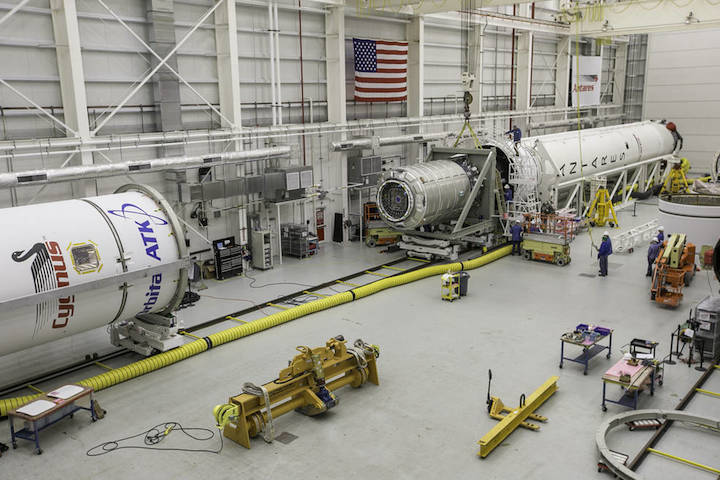
NASA commercial cargo provider Orbital ATK is scheduled to launch its eighth mission to the International Space Station at 7:37 a.m. EST Saturday, Nov. 11 NASA’s Wallops Flight Facility in Virginia. Live launch coverage will begin at 7 a.m. on NASA Television and the agency’s website.
NASA TV also will air two prelaunch briefings Friday, Nov. 10. At 11 a.m. mission managers will provide an overview and status of launch operations, and at 3 p.m. scientists and researchers will discuss some of the investigations and technology demonstrations to be delivered to the station.
The Cygnus cargo spacecraft will launch on Orbital ATK’s upgraded Antares rocket from Pad 0A of Virginia Space’s Mid-Atlantic Regional Spaceport, located at Wallops. Following launch on Nov. 11, NASA TV coverage of the spacecraft’s solar array deployment will begin at 9 a.m. and a post-launch news briefing will held at approximately 10 a.m.
Under NASA’s Commercial Resupply Services contract, Cygnus will carry about 7,400 pounds of crew supplies and hardware to the space station, including science and research in support of dozens of research investigations that will occur during Expeditions 53 and 54.
Cygnus will carry several CubeSats that will conduct a variety of missions, from technology demonstrations of laser communication and increased data downlink rates to an investigation to study spaceflight effects on bacterial antibiotic resistance. Other experiments will advance biological monitoring aboard the station and look at various elements of plant growth in microgravity that may help inform plant cultivation strategies for future long-term space missions. The spacecraft will also transport a virtual reality camera to record a National Geographic educational special on Earth as a natural life-support system.
Cygnus will arrive at the station on Monday, Nov. 13. Expedition 53 Flight Engineers Paolo Nespoli of ESA (European Space Agency) and Randy Bresnik of NASA will use the space station’s robotic arm to capture Cygnus at about 5:40 a.m. NASA TV coverage of rendezvous and capture will begin at 4:15 a.m.
After Canadarm2 captures Cygnus, ground commands will be sent to guide the station’s robotic arm as it rotates and attaches the spacecraft to the bottom of the station’s Unity module. Coverage of installation will begin at 7 a.m.
Cygnus will remain at the space station until Dec. 4, when the spacecraft will depart the station and deploy several CubeSate before its fiery reentry into Earth’s atmosphere as it disposes of several tons of trash.
This Cygnus spacecraft is named in honor of the former astronaut Eugene “Gene” Cernan, the last human to step foot on the Moon during the Apollo 17 mission. Cernan set records for both lunar surface extravehicular activities and longest time in lunar orbit. He died in January 2017.
Quelle: NASA
---
Update: 10.11.2017
.
Antares rocket rolled to Virginia launch pad for station cargo run
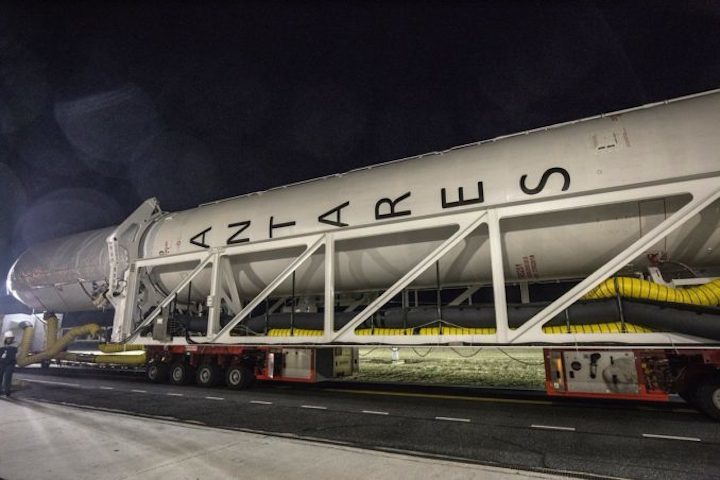
A commercial Antares rocket rolled out of a hangar on a one-mile trip to its launch pad on Virginia’s Eastern Shore on Thursday, ready for final countdown preparations ahead of liftoff Saturday morning on a cargo delivery flight to the International Space Station.
The two-stage Antares launcher, assembled and operated by Orbital ATK, emerged from its horizontal integration building at NASA’s Wallops Flight Facility in the predawn hours Thursday. A self-propelled transporter carried the rocket on a mile-long trip south to launch pad 0A, a complex owned by the Virginia Commercial Space Flight Authority, a state agency chartered to attract commercial space business to the region.
The rocket rolled out in steady rain at the spaceport, and the Antares second stage and payload shroud were protected by a weather shield for the approximately two-hour transfer.
Ground crews engaged hydraulic cylinders to lift the 139-foot-tall (42.5-meter) rocket vertical at pad 0A later Thursday. Technicians then began connecting propellant and other fluid lines between the launch pad and the Antares booster.
Orbital ATK’s automated Cygnus spaceship, christened the S.S. Gene Cernan after the late moonwalker, is fastened on top of the Antares rocket with approximately 7,385 pounds (3,350 kilograms) of cargo and supplies for the space station and its six-person crew.
There is a 95 percent chance of favorable weather for Saturday’s launch attempt, and officials said sub-freezing temperatures expected overnight before launch should not be a problem.
Temperatures are forecast to be between 25 and 30 degrees Fahrenheit at launch time Saturday, above the 20-degree limit for an Antares launch.
Climate-controlled air routed through ducts leading into the Antares rocket will ensure the Cygnus spacecraft, its engines and avionics remain within acceptable temperature and humidity constraints. Three environmental control umbilicals will blow air into the Antares payload fairing, the intertank section between the first stage’s liquid oxygen and kerosene tanks, and into the booster’s aft bay.
“Those three volumes, we keep them nice and cozy in cold weather, and we keep them cool in hot weather, and that enables us to launch in a variety of conditions,” said Kurt Eberly, Orbital ATK’s Antares program manager, in a Facebook Live event Thursday previewing the flight.
“Aside from those cold temperatures … the rest of the key conditions look really excellent,” Eberly said. “The winds are benign, they’re from a good direction coming from the north. Upper level winds look pretty calm as well.”
The launch team will load around 41,000 gallons (155,000 liters) of liquid oxygen and 21,000 gallons (79,000 liters) of rocket-grade kerosene into the Antares first stage beginning around 1 hour, 35 minutes before liftoff.
Saturday’s blastoff will be the eighth time Orbital ATK has launched a resupply mission to the space station. Orbital ATK has used its own Antares rocket launched from Virginia four times — with one launch failure in 2014 — and contracted with United Launch Alliance for three Atlas 5 flights from Cape Canaveral.
Liftoff of the commercial resupply mission, named OA-8, scheduled for 7:37:25 a.m. EST (1237:25 GMT) Saturday to begin the Antares rocket’s seven-minute climb into orbit, kicking off its pursuit of the space station. There’s a five-minute launch window available Saturday.
Two kerosene-fueled RD-181 engines, made in Russia and derived from engines used on Zenit and Atlas 5 rockets, will power the Antares’ Ukrainian-built first stage booster, combining to generate around 864,000 pounds of thrust. Shutdown of the RD-181 engines is planned for T+plus 3 minutes, 34 seconds, followed by first stage separation around six seconds later.
The launch Saturday will be the second Antares mission using RD-181 engines, which Orbital ATK ordered from the Russian engine-builder NPO Energomash to replace decades-old Russian-built AJ26 engines blamed for an Antares rocket crash seconds after liftoff in October 2014.
The RD-181 engines performed better than predicted on an Antares launch in October 2016, giving engineers confidence to loosen performance limits for the OA-8 launch. The engines produce more thrust than the AJ26s, and they will be programmed to fire around five seconds longer on Saturday’s launch than on the last Antares flight.
“We flew to a delta velocity threshold,” Eberly said in a press briefing earlier this year. “When we hit that, we shut down the engines. We had a lot of fuel left in the tanks. Now, we’re just going to move that threshold a little higher and burn more of the fuel in the first stage. At that point in the flight regime, the acceleration is pretty high because the stage is pretty light. Most of the propellant is gone, so you actually pick up quite a bit of performance by burning just a few more seconds into that propellant residual in the tanks.”
With the higher performance, the upgraded Antares can carry approximately 300 pounds more cargo than managers initially expected. The lifting of additional conservative flight constraints, coupled with further minor changes to the vehicle, will further raise the Antares rocket’s payload capacity another 300 pounds in the coming years.
Once the first stage finished its job on Saturday’s launch the Antares rocket’s payload shroud will jettison in two halves at T+plus 4 minutes, 11 seconds. The launcher’s Castor 30XL solid-fueled upper stage will ignite at T+plus 4 minutes, 23 seconds, and burn out at T+plus 7 minutes, 6 seconds, delivering the Cygnus cargo ship to an elliptical orbit less than 200 miles (300 kilometers) above Earth.
Deployment of the Cygnus supply carrier is set for T+plus 9 minutes, 3 seconds.
The spacecraft’s two cymbal-shaped electricity-generating solar arrays will unfurl in a fan-like motion around 90 minutes into the mission, and the ship’s thrusters will begin fine-tuning its approach to the space station with a series of course-correction burns Saturday and Sunday.
The Cygnus spacecraft will make a laser-guided final approach to the orbiting research lab Monday, closing to a distance of around 30 feet (10 meters) from the station. European Space Agency astronaut Paolo Nespoli, assisted by station commander Randy Bresnik, will take control of the lab’s Canadian-built robotic arm to capture the Cygnus.
The arm will attach it to a port on the station’s Unity module, where it will stay until around Dec. 4. Astronauts will unpack experiments and supplies hauled inside the Cygnus’ pressurized module, made by Thales Alenia Space in Italy, then load it with trash and other items marked for disposal.
Payloads slated for delivery to the station on the OA-8 mission include food, clothing and a multitude of research experiments.
The Cygnus spacecraft will raise its orbit to around 300 miles (500 kilometers) after departing the station in early December to release a slew of commercial and NASA-developed CubeSats, then the ship will brake out of orbit with the help of thrusters for a destructive re-entry over the South Pacific Ocean.
Quelle: SN
+++


